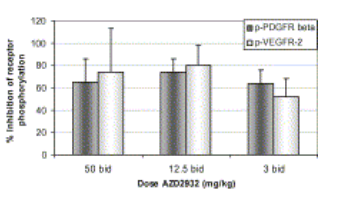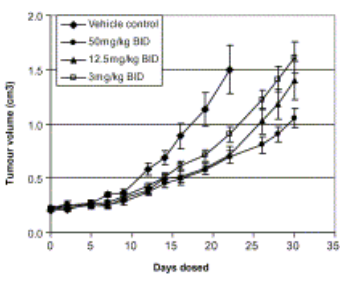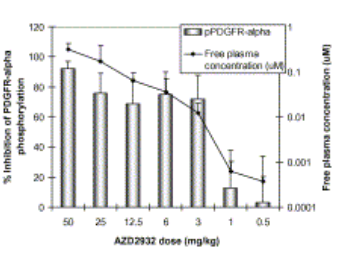
| Size | Price | Stock | Qty |
|---|---|---|---|
| 5mg |
|
||
| 10mg |
|
||
| 25mg |
|
||
| 50mg |
|
||
| 100mg |
|
||
| 250mg |
|
||
| 500mg |
|
||
| Other Sizes |
|
Purity: ≥98%
AZD2932 (AZD-2932), a new quinazoline ether, is a novel, potent, high affinity and mutil-targeted tyrosine kinase inhibitor with potential anticancer activity. Its IC50 values are 8 nM, 4 nM, 7 nM, and 9 nM for VEGFR-2, PDGFRβ, Flt-3, and c-Kit, respectively. AZD-2932 exhibits good selectivity on a panel of kinases and is also active against c-Kit and FLT3. 31 may prove to be an antiangiogenic agent in the clinic based on its pharmacokinetic behavior and preclinical antitumor activity in nude mice with C6 rat glial tumors.
| Targets |
VEGFR2 (IC50 = 8 nM); PDGFRβ (IC50 = 4 nM); FLT3 (IC50 = 7 nM); c-Kit (IC50 = 9 nM)
|
|
|---|---|---|
| ln Vitro |
|
|
| ln Vivo |
|
|
| Enzyme Assay |
AZD2932 is a highly effective and versatile kinase inhibitor that targets VEGFR2, PDGFβ, Flt-3, and c-Kit. In a cell assay, its IC50 values are 8, 4, 7, and 9 nM, respectively.
|
|
| Animal Protocol |
Mice: In order to verify that AZD2932 exhibits comparable effectiveness against PDGFβ and VEGFR-2 phosphorylation, the female nude mice with C6 tumors receive intravenous doses of VEGF-A and PDGFBB five minutes before culling and six hours after the final AZD2932 dose, with the lungs promptly removed. Western blot analysis of lung lysates is performed to detect PDGFβ and total and phosphorylated VEGFR-2 [1].
|
|
| References |
| Molecular Formula |
C24H25N5O4
|
|
|---|---|---|
| Molecular Weight |
447.49
|
|
| Exact Mass |
447.19
|
|
| Elemental Analysis |
C, 64.42; H, 5.63; N, 15.65; O, 14.30
|
|
| CAS # |
883986-34-3
|
|
| Related CAS # |
|
|
| PubChem CID |
11517980
|
|
| Appearance |
Light yellow to yellow solid powder
|
|
| Density |
1.3±0.1 g/cm3
|
|
| Boiling Point |
676.9±55.0 °C at 760 mmHg
|
|
| Flash Point |
363.2±31.5 °C
|
|
| Vapour Pressure |
0.0±2.1 mmHg at 25°C
|
|
| Index of Refraction |
1.629
|
|
| LogP |
3.18
|
|
| Hydrogen Bond Donor Count |
1
|
|
| Hydrogen Bond Acceptor Count |
7
|
|
| Rotatable Bond Count |
8
|
|
| Heavy Atom Count |
33
|
|
| Complexity |
630
|
|
| Defined Atom Stereocenter Count |
0
|
|
| SMILES |
O=C(CC1C=CC(OC2C3C(=CC(=C(C=3)OC)OC)N=CN=2)=CC=1)NC1=CN(C(C)C)N=C1
|
|
| InChi Key |
TWYCZJMOEMMCGC-UHFFFAOYSA-N
|
|
| InChi Code |
InChI=1S/C24H25N5O4/c1-15(2)29-13-17(12-27-29)28-23(30)9-16-5-7-18(8-6-16)33-24-19-10-21(31-3)22(32-4)11-20(19)25-14-26-24/h5-8,10-15H,9H2,1-4H3,(H,28,30)
|
|
| Chemical Name |
2-[4-(6,7-dimethoxyquinazolin-4-yl)oxyphenyl]-N-(1-propan-2-ylpyrazol-4-yl)acetamide
|
|
| Synonyms |
|
|
| HS Tariff Code |
2934.99.9001
|
|
| Storage |
Powder -20°C 3 years 4°C 2 years In solvent -80°C 6 months -20°C 1 month |
|
| Shipping Condition |
Room temperature (This product is stable at ambient temperature for a few days during ordinary shipping and time spent in Customs)
|
| Solubility (In Vitro) |
|
|||
|---|---|---|---|---|
| Solubility (In Vivo) |
Solubility in Formulation 1: ≥ 1 mg/mL (2.23 mM) (saturation unknown) in 10% DMSO + 40% PEG300 + 5% Tween80 + 45% Saline (add these co-solvents sequentially from left to right, and one by one), clear solution.
For example, if 1 mL of working solution is to be prepared, you can add 100 μL of 10.0 mg/mL clear DMSO stock solution to 400 μL of PEG300 and mix evenly; then add 50 μL of Tween-80 to the above solution and mix evenly; then add 450 μL of normal saline to adjust the volume to 1 mL. Preparation of saline: Dissolve 0.9 g of sodium chloride in 100 mL ddH₂ O to obtain a clear solution. Solubility in Formulation 2: 1 mg/mL (2.23 mM) in 10% DMSO + 90% (20% SBE-β-CD in Saline) (add these co-solvents sequentially from left to right, and one by one), suspension solution; with ultrasonication. For example, if 1 mL of working solution is to be prepared, you can add 100 μL of 10.0 mg/mL clear DMSO stock solution to 900 μL of 20% SBE-β-CD physiological saline solution and mix evenly. Preparation of 20% SBE-β-CD in Saline (4°C,1 week): Dissolve 2 g SBE-β-CD in 10 mL saline to obtain a clear solution. View More
Solubility in Formulation 3: ≥ 1 mg/mL (2.23 mM) (saturation unknown) in 10% DMSO + 90% Corn Oil (add these co-solvents sequentially from left to right, and one by one), clear solution. |
| Preparing Stock Solutions | 1 mg | 5 mg | 10 mg | |
| 1 mM | 2.2347 mL | 11.1734 mL | 22.3469 mL | |
| 5 mM | 0.4469 mL | 2.2347 mL | 4.4694 mL | |
| 10 mM | 0.2235 mL | 1.1173 mL | 2.2347 mL |
*Note: Please select an appropriate solvent for the preparation of stock solution based on your experiment needs. For most products, DMSO can be used for preparing stock solutions (e.g. 5 mM, 10 mM, or 20 mM concentration); some products with high aqueous solubility may be dissolved in water directly. Solubility information is available at the above Solubility Data section. Once the stock solution is prepared, aliquot it to routine usage volumes and store at -20°C or -80°C. Avoid repeated freeze and thaw cycles.
Calculation results
Working concentration: mg/mL;
Method for preparing DMSO stock solution: mg drug pre-dissolved in μL DMSO (stock solution concentration mg/mL). Please contact us first if the concentration exceeds the DMSO solubility of the batch of drug.
Method for preparing in vivo formulation::Take μL DMSO stock solution, next add μL PEG300, mix and clarify, next addμL Tween 80, mix and clarify, next add μL ddH2O,mix and clarify.
(1) Please be sure that the solution is clear before the addition of next solvent. Dissolution methods like vortex, ultrasound or warming and heat may be used to aid dissolving.
(2) Be sure to add the solvent(s) in order.
 |
 |
 |